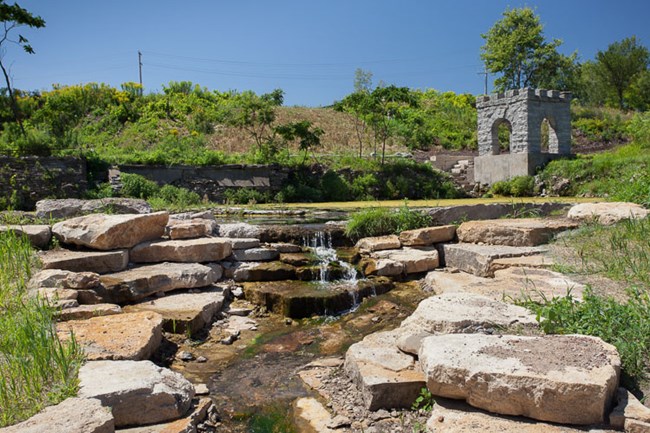
NPS/Gordon Dietzman IntroductionColdwater Spring was added to the Mississippi National River and Recreation Area in January 2010, with the goal of restoring the landscape to an oak savanna/prairie complex. An extensive renovation, which included the removal of twelve buildings and the restoration and seeding of twelve acres of prairie and one acre of wetlands, began in early 2011 and was largely completed by August 31, 2012. During the course of the restoration more than 1,000 trees, shrubs, grasses and wildflowers were planted on the property. The restoration work, however, will continue for many years. HistoryThis area served as an important crossroads for Native Americans and traders using both the Mississippi and Minnesota Rivers for commerce and travel. During the construction of Fort Snelling U.S. soldiers camped at Coldwater Spring, making it the first American settlement in Minnesota. By 1825, construction of the fort had been completed and soldiers had moved from Coldwater into the fort. The area around the spring, however, continued to attract traders, Native Americans, and a small village developed that serviced the trade at the site. The spring also continued to provide water to the new fort and the later Upper Post. The fort initially relied on horse-drawn water wagons and eventually railcars to deliver water from Coldwater Spring up until the 1870s. By 1879, the fort was expanded under Secretary of War, Alexander Ramsey. The fort's expansion demanded a more efficient water supply system and, in 1880, the Army established a formal waterworks at the spring. Coldwater served as the water source for the Army until the 1920s when the Army turned to the City of Saint Paul to supply water for the fort. ActivitiesThe park features a crushed limestone trail for walking to Coldwater Spring. Additionally, there are many opportunities for wildlife viewing and photography. Birdwatching is becoming a popular activity at Coldwater Spring as the savanna/prairie restoration matures and attracts a larger number of species. Turkeys, deer, and even coyotes are not uncommon and native wildflowers bloom throughout the growing season. Additional Information
Hours, Directions and Contact Information
|
Last updated: October 19, 2022
